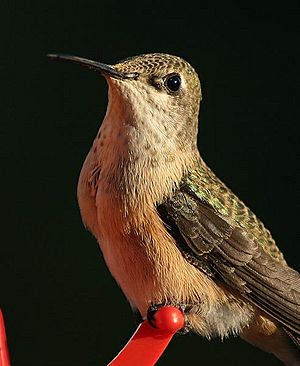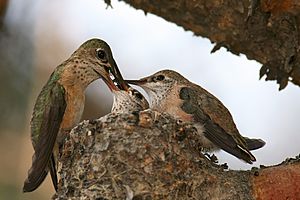Calliope hummingbird facts for kids
Quick facts for kids Calliope hummingbird |
|
|---|---|
 |
|
| Female or immature male | |
| Conservation status | |
| Scientific classification | |
| Genus: |
Selasphorus
|
| Species: |
calliope
|
| Synonyms | |
|
Stellula calliope |
|
The calliope hummingbird (pronounced kə-ˈlī-ə-pē) is the tiniest bird found in the United States and Canada. These amazing birds breed in the western parts of North America. Their breeding range stretches from California all the way up to British Columbia. When winter comes, they fly south to warmer places. They migrate to the Southwestern United States, Mexico, and Central America.
This hummingbird was once thought to be the only member of its own group, called Stellula. But now, scientists believe it belongs to the group Selasphorus. The bird's name comes from Greek mythology. It is named after Calliope, who was a Greek muse. The old group name, Stellula, means "little star".
Contents
What Does It Look Like?
The calliope hummingbird is the smallest bird that nests in Canada and the United States. There is only one smaller hummingbird ever seen in the U.S. That is the bumblebee hummingbird. But it is a rare visitor from Mexico.
An adult calliope hummingbird is very small. It measures about 7 to 10 centimeters (3 to 4 inches) long. Its wings can spread about 11 centimeters (4.3 inches) wide. This tiny bird weighs only about 2 to 3 grams (0.07 to 0.1 ounces). That's about the weight of two paper clips!
Calliope hummingbirds have shiny green feathers on their backs and heads. Their undersides are white. Adult males have special wine-red stripes on their throats. These stripes are called a gorget. They also have green sides and a dark tail. Females and young birds look a bit different. They have a pinkish color on their sides. They also have dark stripes on their throats. Their dark tails have white tips.
Other hummingbirds, like the rufous hummingbird and Allen's hummingbird, look similar. But these birds are bigger. They also have more clear reddish-brown marks on their tails and sides.
Where Do They Live?
Calliope hummingbirds live in many different places. They like open areas with shrubs and bushes. They also live at different heights in the mountains. They usually build their nests in the higher parts of the Rocky Mountains.
Nests have been seen as low as 180 meters (600 feet) in Oregon and Washington. They can also be found up to the tree line at over 3,350 meters (11,000 feet). In Montana, they nest at least 1,200 meters (3,900 feet) high. They like open mountain forests, meadows, and areas with willow and alder trees.
During their migration and in winter, they live in other places. These include chaparral, low-lying bushy areas, and deserts. They nest in western North America. This area goes from southern British Columbia and Alberta down to Colorado and southern California. In spring and summer, they travel. They mostly fly through Arizona, New Mexico, and northern Mexico. They spend their winters in southwestern Mexico, Guatemala, and Belize.
How Do They Behave?
Calliope hummingbirds are migratory birds. This means they travel long distances. They usually leave their nesting areas earlier than most birds. This helps them find late-summer wildflowers in the mountains. These flowers provide food. They are thought to be the smallest birds in the world that travel such long distances.
These birds eat nectar from flowers. They use their long tongues to reach the sweet liquid. They also drink sap from holes made by sapsucker birds. Sometimes, they catch insects while flying. When they collect nectar, they also help plants. They carry pollen from one flower to another, which is called pollination. They like to pollinate flowers like paintbrush, penstemon, columbine, and trumpet gilia. They also eat small insects and spiders.
Male calliope hummingbirds usually arrive at the breeding grounds first. This happens from mid-April to early May. The male chooses a nesting area and protects it. He will mate with several females. The male does not help raise the young birds. He often leaves the area by the time the babies hatch.
The female builds a cup-shaped nest. She usually builds it in a conifer tree under a branch. Sometimes, she uses apple or alder trees. The nest is often built on the base of large pine cones. It looks a bit like a pine cone itself. A nest can be used again for several years. The female lays two eggs from late May to early July. She sits on the eggs for 15 to 16 days. The young birds can fly about 20 days after they hatch.
Courtship Dance
During courtship, male calliope hummingbirds perform a special dance. They hover in the air, flapping their wings very fast. They can flap up to 95 times per second. This makes a loud buzzing sound. Their throat feathers stick out towards the female.
The male then flies up about 20 meters (65 feet). He then dives down very fast. As he dives, his wings and tail feathers make sounds. He also makes calls. All of this is to get the female's attention. Scientists have studied these displays. They found that the male makes sounds from three different parts of his body. Each sound is unique. This means they might send different messages to the female. The tail feathers flutter and hit each other to make the buzzing sound.
Staying Cool
Calliope hummingbirds have a very fast metabolism. This is especially true when they fly fast or hover. This creates a lot of body heat. They need special ways to cool down. This is even harder in hot, humid places.
Since they are the smallest hummingbirds in North America, they have a large surface area for their size. This helps them cool down. Air moving from their wings helps to carry heat away. When the air temperature goes above 36 degrees Celsius (97 degrees Fahrenheit), it's harder to cool down. Then, they mostly cool off by breathing out air and through evaporation.
All hummingbirds cool down partly by breathing out air. They also lose heat from parts of their body with thin or no feathers. These areas include around their eyes, shoulders, under their wings, and their feet. When hovering, they don't get as much cooling from air movement. But the fast movement of their wings might help cool their extended feet.
Status of the Species
Many pollinator species, like the calliope hummingbird, have seen their numbers go down. We don't have much information on why this is happening. But some possible reasons include losing their homes. More use of pesticides is also a threat. Replacing native plants with non-native ones can also be a problem. However, some hummingbirds benefit from non-native plants in gardens. These plants give them extra food.
The calliope hummingbird's winter home is small. This makes them more at risk from natural disasters or diseases. Changes in how land is used could also harm many of them. The calliope hummingbird has not been studied a lot. So, much about its life is still unknown.
See also
 In Spanish: Colibrí calíope para niños
In Spanish: Colibrí calíope para niños




